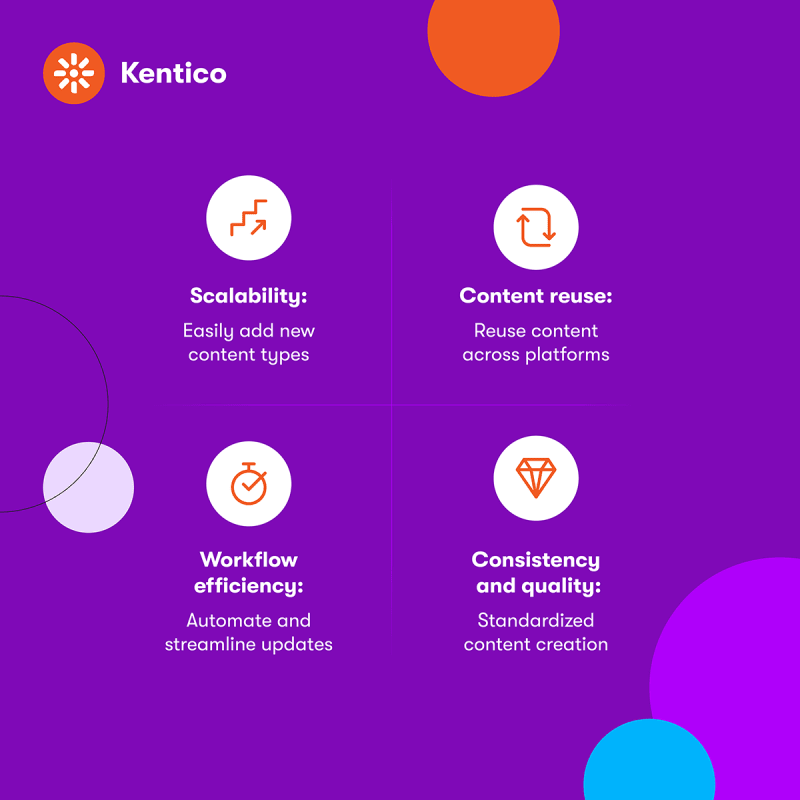In today's digital world, managing content across different platforms and channels can be a real challenge for marketers. Without a structured plan, every piece of content, like blog posts or product descriptions, often needs to be manually adjusted to fit different formats. This can lead to inconsistencies, more work, and a higher chance of mistakes. A lack of a clear content strategy can cause confusion and make it hard to maintain a consistent brand image
Content modeling is a solution that brings order and efficiency to content management. It involves defining and organizing the various types of content and their attributes and relationships. Think of it as creating a detailed plan for your digital content.
By setting up a clear structure, content modeling ensures that all content is consistently managed and can easily adapt to different platforms and user needs. This article will explain the basics of content modeling and how it can help businesses manage their digital content better, making operations more efficient and enhancing user engagement.
What is content modeling?
Content modeling is the process of defining and organizing the different types of content you'll manage in a content management system (CMS) or digital experience platform (DXP).
Just as an architect designs a house by specifying the rooms, their features, and how they connect, content modeling involves identifying the various types of content you need, detailing their specific attributes, and establishing their relationships.
Types of content: These are like the rooms in your house (e.g., living room, kitchen, bedroom). In a website, these are types of content such as articles, products, assets, or user profiles.
Attributes (fields): These are the characteristics of each room. For example, a living room might have attributes like a fireplace, windows, and doors. Similarly, an article might have attributes like a title, teaser, body, publication date, and author.
Relationships: These define how the rooms connect and interact. For instance, how the living room connects to the kitchen. In content terms, it’s how articles link to their authors, categories, or tags.
Your content model serves as the blueprint for managing your digital content. It ensures that each type of content is clearly defined, organized, and interconnected, making it simpler to manage and consistently present across all channels. This structured approach acts as a robust foundation for your content strategy, guiding your team in creating, structuring, and linking content in a cohesive manner that meets both business objectives and user needs.
With a well-defined content model, you establish a flexible and scalable framework that supports efficient content management and seamless delivery across multiple platforms and devices. This framework allows you to easily adapt to new content demands and technological changes, ensuring that your content remains organized, accessible, and aligned with your users' evolving expectations.

How content modeling works
As we’ve seen, content modeling is akin to designing a blueprint for organizing information within a digital system. It provides a structured approach that ensures every piece of content is logically integrated, making it easy to manage, organize, and present. With a clear content model, each type of content and its relationships are meticulously defined, allowing for seamless integration and consistent presentation across all platforms. Let's delve deeper into how content modeling works:
- First, you define the different types of content you'll have, like articles, product pages, event pages, or user profiles. Each type serves a distinct purpose on your website or application. This is easy to imagine if you look at your existing or old website and think about how to categorize your content into types. Remember, you may also want some of the content types to be reusable.
- Next, you detail the specific attributes or characteristics that each type of content will have. For instance, an article might include a title, body text, publication date, and author.
- Then, you determine the relationships between these different types of content—how they connect and interact with each other. For example, an article might be linked to an author and categorized under a specific topic.
- After setting up the types, attributes, and relationships, you populate your model with actual content items. Each content item is an instance of a content type with specific values for its attributes. For example, to create a new article, you’d select the content type Article, then fill in the fields (a bit like a template) to produce a new content item—an individual article, with its unique title, text, and publication date.
- Finally, you use this model to manage and present your content consistently. Your content management system (CMS) or digital experience platform (DXP) will use the defined model to structure and display content according to the blueprint you’ve created.
So, imagine you're setting up a blog. Your content model might include:
Content types:
Articles
Authors
Categories
Attributes:
Articles > title, body, publication date, and author
Authors > name, bio, and photo
Categories > news, events, industry updates
Relationships:
An Article would be linked to its Author
It would be assigned a Category
Once you have this model, creating and organizing blog posts becomes straightforward. Each new blog post (content item) follows the predefined structure, ensuring consistency and making it easier to manage your content as your blog grows.
Here’s what the content type Article looks like in Xperience by Kentico.

When a content creator creates a new article, they are prompted to fill in a series of predefined fields. This standardization ensures that every article is created in a consistent manner, regardless of who is crafting it.
Some fields require straightforward input, like the title, teaser, summary, and main text, as they are unique to the specific article. Other fields, however, involve selecting from existing content within the content hub. For example, instead of re-entering the author’s details, inputting article type, or finding related articles, they can choose from a pre-existing list, ensuring that this information remains uniform across the site.
Once the article is published, any reused content remains consistent wherever it appears. If there's a need to correct a typo in a shared piece of content, such as the author's bio or a related article, updating it at its source automatically reflects the changes everywhere it’s used.
Furthermore, by breaking content down into fields, newly created content—like the content inputted in "Article Teaser"—become versatile assets in themselves. This means that when you’re compiling a newsletter showing off your recent articles, you can add this article to the newsletter simply by selecting the particular fields you require (Article Title, Article Teaser, URL) this Article Teaser from the list of all article teasers, the content hub, without needing to copy and paste, or rewrite anything new, or delete unwanted fields. This reuse not only saves time but also ensures consistency and accuracy across all your content channels.

Transform your digital strategy with content modeling
By understanding and using content modeling, you create a strong framework that makes managing your digital content easier, more flexible, and more effective at meeting your audience's needs.
Let’s explore the many benefits of using a content model.
Optimized content management: Predefined content structures simplify the process of curating, updating, and managing content, efficiently handling large volumes.
Enhanced consistency and quality: All content pieces adhere to the same structure and standards, promoting uniformity and reducing errors. This is particularly valuable in large organizations with diverse teams producing content.
Scalability: A robust content model supports efficient scaling of content creation and management processes. It allows the seamless addition of new content types without disrupting existing frameworks.
Improved content reuse: Content models facilitate the reuse of content across different platforms and channels. For instance, a product description can be used on the website, in marketing emails, and on social media without manual duplication.
Streamlined workflow and automation: Content models enable the implementation of automated workflows, reducing manual intervention and speeding up processes like content publishing and updates.
Multichannel distribution: Content modeling enables multichannel publishing, allowing marketing teams to create content once and distribute it across different websites, microsites or landing pages, emails, social media, mobile apps, etc. without extra modifications.
Improved customer experience: Content modeling enables the creation of personalized customer journeys by delivering contextually relevant content. It also enhances navigation and accessibility for users across different marketing channels.
Compliance and governance: Clearly defined content types ensure compliance with industry regulations and internal policies, maintaining adherence to necessary standards across all content.
Enhanced analytics and insights: Consistent content attributes make it easier for marketing teams to track performance and derive actionable insights. This enables better understanding of what content strategies are effective.
Flexibility and agility: Content models simplify adapting to changes in strategy or market demands. Teams can quickly adjust or create new content types without overhauling the entire system
Better SEO: Content modeling ensures content is logically and semantically structured, improving its indexability and understanding by search engines. This boosts the likelihood of reaching the target audience.
Future-proofing: A clearly defined content model prepares content systems for future technological advancements, ensuring they remain relevant and adaptable to evolving user needs and business goals. Should an organization wish to move to another CMS in the future, the content structure will be organized and standardized, facilitating a smoother transition and reducing the complexity and cost associated with migrating to a new platform.
While a well-defined content model lays the foundation for efficient content management and delivery, its true potential is realized only when paired with the right technology. The appropriate Digital Experience Platform (DXP) seamlessly integrates with your content model, enhancing its capabilities and ensuring smooth, consistent execution.
Choosing the right tools is essential to fully harness the benefits of your content model, enabling your organization to remain agile and responsive in today’s fast-paced digital landscape.
Do you want to go further on content modeling? Download our recent ebook!
Content modeling: The what, the why, and the how
Discover how content modeling can help you master digital content management.

